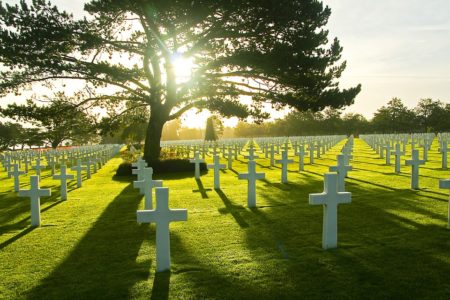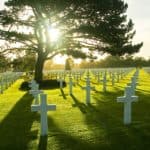
27
AprD-Day in a Day
 D-Day in a Day
D-Day in a Day
“You are about to embark upon the Great Crusade, toward which we have striven these many months. The eyes of the world are upon you. The hopes and prayers of liberty-loving people everywhere march with you… We will accept nothing less than full victory!”
Yikes. Talk about pressure.
You may recognize these words, or at least the occasion that prompted them. They were spoken on the eve of June 6, 1944 by Supreme Allied Commander Dwight D. Eisenhower as he sent hundreds of thousands of soldiers across the English Channel to Normandy, France to launch the largest amphibious assault in history. That event, Operation Overlord, culminated in the ultimate liberation of Europe from Nazi Germany. We know of it as D-Day.
I decided to include a detour to Normandy during my upcoming trip to visit my daughter in Paris. I hoped she’d come too. Whether it was a burning desire to experience first-hand the bloodied battlegrounds of history or the fact that the trip was on someone else’s euro, Belle was all in. Laptop in hand, she sprang into action to book us an airbnb, but where? I admit to some particular preferences when it comes to international travel. I’m up for almost any adventure—as long as it has the Rick Steves seal of approval.
My soft spot for Rick is no secret. His travel guides are fun to read, easy to follow, and bursting with helpful tips, maps, walking tours, itineraries, and places to eat, sleep, and be merry. Don’t even get me started on his downloadable audio tours.I beelined to the travel section of the library and grabbed “Rick Steves France 2017.”
Rick raves about the romantic port of Honfleur renowned for its history, picturesque harbor, and “unusual luminosity.” I was sold; Belle wasn’t buying it. Taking her friends’ advice, she proposed the small seaside resort of Etrétat. I caved, but only because Rick too gave it the nod.
Etrétat did not disappoint. Steps from our cozy accommodations I stood on the exact spot where Monet painted numerous seascapes of the dramatic scene directly opposite, a reproduction of which was there on display.
We started our sightseeing in Arromanches, part of Gold Beach in the British landing zone, with the 360 degree surround-sound film, “Normandy’s 100 Days.” Head swiveling, I tried to take in all the archival footage and photographs of German and Allied soldiers in action and the joy on the faces of the townspeople welcoming their liberators. I was blinking back tears by the end.
Our next stop, at Rick’s suggestion, was the Germany gun battery at Longues-sur-Mer. We wandered around the massive pillboxes, their iron hooks for securing camouflage netting still intact. In the observation bunker by the water I tried not to eavesdrop too conspicuously on a private tour. One tidbit I couldn’t help overhear: an Allied bomb had fortuitously struck the underground telephone wire, cutting off communication between the look-out and the gunners who were then forced to rely on their own inferior aim. I love hearing stuff like that. Next time I might splurge and hire my own guide; Rick recommends several.
By late afternoon we reached Omaha Beach, the site of the first American D-Day landing so powerfully portrayed in Spielberg’s “Saving Private Ryan.” Remember the opening scene, with Tom Hanks and his terrified men scrambling to shore while trying to avoid being slaughtered?
At the American Cemetery in Normandy, a pilgrimage site for both veterans and history buffs, we walked on manicured Kentucky bluegrass among endless rows of white marble gravestones. From the bluff overlooking the now bleak and deserted beach, we followed the haunting notes of a trumpet back to the cemetery. Everyone stood still as the two American flags were lowered at sunset, listening in silence to the final strains of taps.
Traipsing around bunkers and beaches all day takes its toll, so we went in search of fortification. I consulted Rick, who steered us to a 10th century farm offering cider and Calvados tastings. Or he tried to, anyway; it was closed until spring.
There are dozens of D-Day museums, monuments, and memorials open to the public. We saw only a handful. Because dusk was approaching we missed out on another moving site—the Pointe du Hoc Monument, where specially trained U.S. Army Rangers scaled an impossibly sheer cliff face to take out the Germany gun battery. Next time.
Chilled and emotionally spent, we headed home. We made it to Honfleur after all, ending the day at one of the harborside bistros under the warmth of a heat lamp.
If traveling 3,000 miles across the Atlantic isn’t convenient, you can experience this slice of history vicariously at the library. For historical fiction fans, “The Nightingale” by Kristin Hannah and Anthony Doerr’s “All the Light We Cannot See” are two compelling accounts of the French Resistance and life under German occupation. Another page-turner just published is “The Baker’s Secret” by Stephen Kiernan, a wonderful story of the resilience of the human spirit set in a Normandy village on the eve of D-Day. My all-time favorite World War II saga, however, is Herman Wouk’s “The Winds of War,” featuring a combination of real and fictional characters connected to the family of Victor “Pug” Henry, a naval officer and confidant of President Roosevelt, and its sequel, “War and Remembrance.”
For non-fiction devotees, Dan Van Der Vat’s “D-Day: the Greatest Invasion, a People’s History” is my top pick. Beautifully illustrated, it contains hundreds of color and black and white photographs as well as paintings by war artists and never-before-published eyewitness accounts. It’s fascinating.
Another illustrated military history I liked, because it doesn’t really read like one, is “D-Day: June 6, 1944” by Richard Collier. He opens—and I will close–with this poem from an anonymous author:
TO THE MEN AND WOMEN OF D-DAY
Went the day well?
We died and never knew.
But, well or ill,
Freedom, we died for you.
April Cushing is the Head of Adult and Information Services at the Morril Memorial Library in Norwood, Mass. Read her column in the April 27, 2016 issue of the Norwood Transcript & Bulletin.







